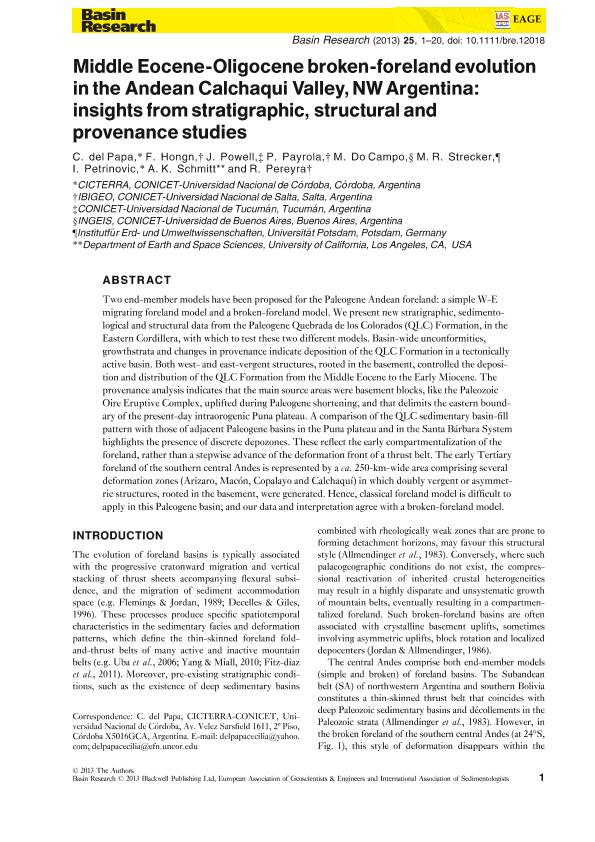Artículo
Middle Eocene-Oligocene Broken Foreland Evolution In The Andean Valle Calchaqui, Nw Argentina: Insights From Stratigraphic, Structural And Provenance Studies
del Papa, Cecilia Eugenia ; Hongn, Fernando Daniel
; Hongn, Fernando Daniel ; Powell, Jaime Eduardo
; Powell, Jaime Eduardo ; Payrola, P.; Do Campo, Margarita Diana
; Payrola, P.; Do Campo, Margarita Diana ; Strecker, M.; Petrinovic, Ivan Alejandro
; Strecker, M.; Petrinovic, Ivan Alejandro ; Schmitt, A.; Pereyra Hafner, Ricardo Eduardo
; Schmitt, A.; Pereyra Hafner, Ricardo Eduardo
 ; Hongn, Fernando Daniel
; Hongn, Fernando Daniel ; Powell, Jaime Eduardo
; Powell, Jaime Eduardo ; Payrola, P.; Do Campo, Margarita Diana
; Payrola, P.; Do Campo, Margarita Diana ; Strecker, M.; Petrinovic, Ivan Alejandro
; Strecker, M.; Petrinovic, Ivan Alejandro ; Schmitt, A.; Pereyra Hafner, Ricardo Eduardo
; Schmitt, A.; Pereyra Hafner, Ricardo Eduardo
Fecha de publicación:
09/2013
Editorial:
Wiley
Revista:
Basin Research
ISSN:
0950-091X
Idioma:
Inglés
Tipo de recurso:
Artículo publicado
Clasificación temática:
Resumen
Two end-member models have been proposed for the Paleogene Andean oreland: a simple W-Emigrating foreland model and a broken-foreland model. We present new stratigraphic, sedimentological and structural data from the Paleogene Quebrada de los Colorados (QLC) Formation, in the Eastern Cordillera, with which to test these two different models. Basin-wide unconformities, growthstrata and changes in provenance indicate deposition of the QLC Formation in a tectonically active basin. Both west- and east-vergent structures, rooted in the basement, controlled the depositionand distribution of the QLC Formation from the Middle Eocene to the Early Miocene. The provenance analysis indicates that the main source areas were basement blocks, like the Paleozoic Oire Eruptive Complex, uplifted during Paleogene shortening, and that delimits the eastern boundary of the present-day intraorogenic Puna plateau. A comparison of the QLC sedimentary basin-fill pattern with those of adjacent Paleogene basins in the Puna plateau and in the Santa Barbara System highlights the presence of discrete depozones. These reflect the early partmentalization of the foreland, rather than a stepwise advance of the deformation front of a thrust belt. The early Tertiary foreland of the southern central des is represented by a ca. 250-km-wide area comprising several deformation zones (Arizaro, Macon, Copalayo and Calchaquı) in which doubly vergent or asymmetric structures, rooted in the basement, were generated. Hence, lassical foreland model is difficult to apply in this Paleogene basin; and our data and interpretation agree with a broken-foreland model.
Palabras clave:
Cuencas Sedimentarias
,
Argentina
,
Eoceno
,
Sedimentologia
Archivos asociados
Licencia
Identificadores
Colecciones
Articulos(CCT - NOA SUR)
Articulos de CTRO.CIENTIFICO TECNOL.CONICET - NOA SUR
Articulos de CTRO.CIENTIFICO TECNOL.CONICET - NOA SUR
Articulos(CICTERRA)
Articulos de CENTRO DE INVEST.EN CS.DE LA TIERRA
Articulos de CENTRO DE INVEST.EN CS.DE LA TIERRA
Articulos(IBIGEO)
Articulos de INST.DE BIO Y GEOCIENCIAS DEL NOA
Articulos de INST.DE BIO Y GEOCIENCIAS DEL NOA
Articulos(INENCO)
Articulos de INST.DE INVEST.EN ENERGIA NO CONVENCIONAL
Articulos de INST.DE INVEST.EN ENERGIA NO CONVENCIONAL
Articulos(INGEIS)
Articulos de INST.DE GEOCRONOLOGIA Y GEOLOGIA ISOTOPICA (I)
Articulos de INST.DE GEOCRONOLOGIA Y GEOLOGIA ISOTOPICA (I)
Citación
del Papa, Cecilia Eugenia; Hongn, Fernando Daniel; Powell, Jaime Eduardo; Payrola, P.; Do Campo, Margarita Diana; et al.; Middle Eocene-Oligocene Broken Foreland Evolution In The Andean Valle Calchaqui, Nw Argentina: Insights From Stratigraphic, Structural And Provenance Studies; Wiley; Basin Research; 25; 5; 9-2013; 574-593
Compartir
Altmétricas



